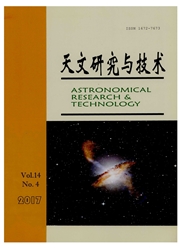

 中文摘要:
中文摘要:
CCD天文图像在采集过程中会受到各种噪声的影响,其中宇宙射线噪声有时会严重影响到图像中的有用信息。研究如何有效识别和剔除宇宙射线噪声对于天文图像的信息提取是非常重要的。针对目前国际上较新的三种消除宇宙射线的算法:Laplacian边缘检测算法(ALaplacian Edge Detection Algorithm),基于直方图的快速算法(A Fast Algorithm Based On Histogram)以及万能噪声消除算法(AUniversal Noise Removal Algorithm),采用由云南天文台1m望远镜拍摄的CCD图像进行了模拟实验和实际宇宙射线的处理。实验表明Laplacian边缘检测算法能相对准确地探测到恒星和星系图像上的宇宙射线。并对算法的效果和复杂度进行比较和分析。最后探讨了如何准确替代宇宙射线像素点的灰度值。
 英文摘要:
英文摘要:
During their acquisitions astronomical CCD images are affected by a variety of noises, among which cosmic rays sometimes directly affect useful information in the images. It is very important to effectively identify and remove the cosmic rays noise for the extraction of information from an astronomical image. For the three present algorithms to remove cosmic rays the Laplacian edge detection algorithm, the fast algorithm based on histogram, and the universal noise removal Algorithm, we use them to process CCD images taken at the Yunnan Observatory with the 1-meter telescope with either actual or simulated cosmic-ray hits. We compare and analyze the levels of effectiveness and complexity of these algorithms. Processing results show that the Laplacian edge detection algorithm can most accurately detect cosmic rays in images of stars and galaxies. We also discuss how to accurately substitute the values of the pixels affected by cosmic rays.
 同期刊论文项目
同期刊论文项目
 同项目期刊论文
同项目期刊论文
 期刊信息
期刊信息
